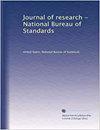Some optical and crystallographical properties of the alkali zinc uranyl acetates
引用次数: 2
Abstract
The optical properties and crystal form of the zinc uranyl acetates of sodium, lithium, and potassium were determined. The lithium and sodium zinc uranyl acetates belong to the monoclinic system and are isomorphous. They are capable of forming a series of solid solutions, as is evidenced by the homogeneity and the intermediate optical properties and X-ray pattern of a mixed sodium and lithium zinc uranyl acetate. The potassium zinc uranyl acetate belongs to the tetragonal system and differs from the lithium and sodium zinc uranyl acetates in optical properties and crystal form. In studying the application of the Barber and Kolthoff method l for the quantitative determination of sodium to the analysis of glass, 2 a casual examination of the crystalline precipitate showed that the crystals were, in general, very well formed and were characterized by twinning. Barber and Kolthoff stated that part of the potassium and most of the lithium are precipitated with the sodium salt when they are present. Glaze has recently substantiated Barber and Kolthoff's statement that lithium cannot be separated from sodium, but has shown that potassium can be separated from sodium if proper precautions are taken. 3 Hence it seemed desirable to make a detailed study of the three salts to see if they can be readily distinguished by their optical properties. The crystalline compounds used in this work were prepared as follows: One volume of a solution of cp alkali chloride was mixed with 10 volumes of the zinc uranyl acetate reagent 4 and stirred frequently during 30 minutes. The precipitate was filtered and washed free from the excess reagent with 95 percent alcohol and finally with etber. The precipitate was dissolved in a minimum amount of distilled water and recrystallized by slowly concentrating the solution in a dessicator over sulphuric acid. In the case of the potassium salt a few drops of acetic acid were added to prevent hydrolysis. Microscopic examination of the sodium and lithium salts showed them to be perfectly homogeneous and without visible impurity. Analyses of these two salts were made as follows: The uranium was converted to sulphate by fuming with sulphuric acid, reduced in a Jones reductor, oxidized to quadrivalent uranium with air and i Jour. Am. Chem. Soc, vol. 50, pp. 1625-1631, 1928. « F. W. Glaze, Jour Am. Cer. Soc, vol. 14, no. 6, pp. 450-453, 1931. 3 B.S. Technical News Bulletin No. 94, p. 68, June 1933. * Barber and Kolthofi, op. cit., p. 1626. 471 472 Bureau oj Standards Journal of Research [Vol. IB titrated with permanganate. The zinc was precipitated from a 0.008 N sulphuric acid solution by hydrogen sulphide. The precipitate was dissolved and reprecipitated until white in color, filtered, and ignited to the oxide. The alkali was determined as sulphate on a separate sample after removing the uranium and zinc as sulphides from an ammoniacal solution. On the lithium salt water was determined at 100 C and 3 mm pressure and the acetic acid was determined by distilling from a phosphoric acid solution and titrating with standard sodium hydroxide. The results of the analyses are given in table 1 together with the compositions calculated from the formulas (see footnote 4).碱醋酸铀酰锌的光学和晶体学性质
测定了醋酸铀酰锌钠盐、锂盐和钾盐的光学性质和晶体形态。锂和醋酸铀酰锌钠属于单斜晶系,是同晶的。它们能够形成一系列的固溶体,这可以从钠和醋酸铀酰锌锂混合的均匀性、中间光学性质和x射线图中得到证明。醋酸铀酰锌钾属于四方系,与醋酸铀酰锌锂和醋酸铀酰锌钠的光学性质和晶体形态不同。在研究巴伯法和科尔霍夫法(用于钠的定量测定)在玻璃分析中的应用时,对结晶沉淀物的偶然检查表明,总的来说,晶体形成得很好,并以孪生为特征。Barber和Kolthoff指出,当钠盐存在时,部分钾和大部分锂会随着钠盐析出。格莱兹最近证实了巴伯和科尔霍夫的说法,即锂不能从钠中分离出来,但如果采取适当的预防措施,钾可以从钠中分离出来。因此,似乎有必要对这三种盐进行详细的研究,看看能否根据它们的光学性质轻易地加以区分。本研究所用结晶化合物的制备方法如下:将1体积cp氯化碱溶液与10体积醋酸铀酰锌试剂4混合,反复搅拌30分钟。沉淀物经过过滤,用95%的酒精,最后用乙醚除去多余的试剂。沉淀物溶解在最少量的蒸馏水中,并通过将溶液在硫酸上缓慢浓缩在干燥器中再结晶。在钾盐的情况下,加入几滴醋酸以防止水解。钠盐和锂盐的显微检查表明它们完全均匀,没有可见的杂质。对这两种盐作了如下的分析:用硫酸发烟将铀转化为硫酸盐,在琼斯还原剂中还原,用空气和镍氧化成四价铀。点。化学。社会,第50卷,第1625-1631页,1928。——《早安》f·w·格莱兹Cer。社会科学,第14卷,第2期。6,第450-453页,1931年。3《学院技术新闻通报》第94期,第68页,1933年6月。*巴伯和科尔托菲,同城,第1626页。[71][72]美国标准研究杂志[卷b] .高锰酸盐滴定。用硫化氢从0.008 N的硫酸溶液中析出锌。沉淀被溶解和再沉淀,直到白色,过滤,并点燃的氧化物。从氨溶液中除去铀和锌作为硫化物后,在另一个样品上测定碱为硫酸盐。在锂电池上,在100℃和3mm压力下测定盐水,通过从磷酸溶液中蒸馏并用标准氢氧化钠滴定来测定乙酸。分析结果连同根据公式计算出的成分列于表1中(见脚注4)。
本文章由计算机程序翻译,如有差异,请以英文原文为准。
求助全文
约1分钟内获得全文
求助全文

 求助内容:
求助内容: 应助结果提醒方式:
应助结果提醒方式:


